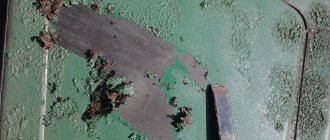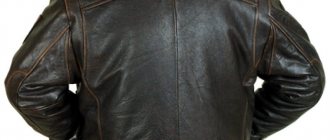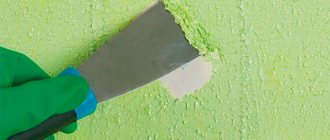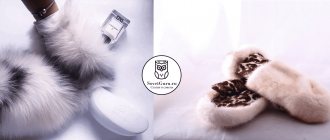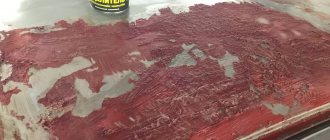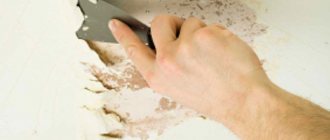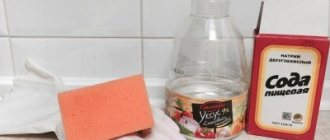When carrying out any restoration work, the first thing you need to do is remove the old paint from the metal. It is produced to ensure a more uniform application of new layers of paint and varnish composition, for better contact of the applied coating with the surface being treated. Mechanical fashion is becoming an increasingly popular design direction, hence the increased interest in how to remove paint from products.
To understand how to remove old paint from metal, you need to know all the known methods that currently exist.
Selecting a washing method
If you want to change the paint on any metal object, you need to be patient. The first step is to remove the paint layer.
- Manufacturers are striving to improve their paint and varnish products.
- When repainting metal, this can become a serious problem: it is impossible to manually remove the old layer of paint due to its resistance to external factors.
- Therefore, you need to prepare before starting work: stock up on the appropriate equipment, find time, space, etc.
To remove the paint layer, there are 3 methods. Each of them is used in different conditions and depends on how many layers of paint are applied, how much money is allocated for this process, the type of paint, the availability of the required tools, etc.
Before you start washing off the paint, you should familiarize yourself with the following methods and choose the most optimal one.
The most common mistakes
- Working with a hairdryer or burner in a poorly ventilated area. When exposed to high temperatures, paint releases toxic fumes. Without ventilation, the risk of gaseous toxins entering the respiratory tract and, as a result, poisoning increases. It is better to carry out all work outside.
- Skipping the preparatory stage. If you do not cover nearby surfaces with film before work, they may become dirty or damaged by solvents and elevated temperatures. If the metal is not moistened with water before mechanical cleaning, then the dust and dirt formed during removal will fill all the air in the room.
- Heat treatment of brass and cast iron products. Under the influence of increased temperature °C, scale forms on these metals, and the alloys become brittle, which leads to the destruction of the materials.
- Neglect of safety precautions. Without glasses, gloves and a respirator, the likelihood of injury to the mucous membranes of the eyes, nasopharynx and skin increases.
- Mechanical cleaning of thin sheet metal. Due to strong mechanical influence, fragile objects can deteriorate, lose their shape, and receive dents that will be difficult to fix.
To avoid mistakes, before choosing a cleaning method, you need to accurately determine the metal and the paint with which it is coated.
Mechanical method
This method is the most difficult. It takes a lot of physical strength to remove paint mechanically. But this method does not require as much money as the other 2 methods require. In this way, paint was removed from metal in those days when special compounds had not yet been invented.
Necessary items: sandpaper and any power tool. You can also use a sharp knife.
The process of removing the previous paint layer involves manually picking it out. Then the remaining debris should be washed off with water.
What are the disadvantages of the mechanical method?
- This is extremely hard physical work. The larger the surface to be treated, the more time and effort you will have to spend.
- There is a risk of damaging the surface.
- After finishing work, everything around will be covered in dust, which can negatively affect your health.
- The method does not work for many types of paint.
Despite the severity, people still wash off paint in this way, regardless of the size of the surface being treated.
Preparatory stage
Before you begin work, you should be properly prepared. The complex of preparatory work will include the following:
- Buy the necessary tools for the procedure, as well as household chemicals. Depending on the cleaning method you choose, you may need a hair dryer, a sanding machine, paint remover, kerosene, a spatula, a brush, etc.
- Protect all objects that are located near the cleaning site from dust and other types of contaminants. To do this, use polyethylene film.
- Prepare personal protective equipment in advance, and if we talk about the classic set, it includes construction glasses (safety glasses), gloves, and a respirator.
- Prepare the metal surface for future cleaning, namely, you need to remove dust and other contaminants from it, and if you use household chemicals, you can clean the paint with a brush equipped with stiff bristles. This will increase the diffusion of the solvent and also speed up the reaction.
After all stages are completed, the work can begin.
How to remove plaque from brass
To renew the appearance of small brass items, you need to use a detergent. To do this, place the item in a pan with water and detergent and leave to boil for several hours. Then pull out the product and use a nylon brush to remove the paint. After this, to protect it from rust, you need to wipe the product with a rag with wax.
Next, the metal is primed and becomes available for applying a new paint layer.
Preparing for cleaning
- Collection of tools and chemical reagents for metal cleaning. The work may require a sanding machine, a hair dryer, paint thinner, a spatula, a brush and other equipment.
- Protection of surrounding surfaces from contamination. All items that cannot be processed are covered with polyethylene.
- Personal protection. Protective equipment is prepared: gloves, goggles or mask, respirator.
- Metal preparation. Dust and dirt are removed from the base. For severe contamination, use household chemicals and a metal brush. Brushing improves the solvent's ability to penetrate the paint layer and speeds up its reaction.
Thermal method
Required items: blowtorch, gas burner. This method will be effective if you need to remove several layers of old paint at once. However, the method is fire hazardous and is rarely used.
First, the surface to be treated must be washed. After this, heat it until the paint begins to bubble. In this state it is easier to remove it with a knife.
Precautionary measures must be observed: when working with the burner, you must ensure that there are no flammable objects nearby. Also, do not allow hot paint to come into contact with your skin. This will cause burns.
Disadvantages of the thermal method:
- This process cannot be carried out indoors, since toxic substances are released when the paint is heated.
- The operation cannot be carried out if the surface being treated is brass or cast iron.
- Also, some types of metals may lose their original shape when heated.
Folk remedies
The oil coating can also be removed:
- A mixture of turpentine and ammonia in a ratio of 2:1. It will take about an hour for the paint to dissolve.
- A solution of quicklime and potash (70/30). The composition is diluted with water until a viscous consistency is formed. It will take 12 hours for the paint to dissolve.
- A mixture of chalk and lime paste in a 1:1 ratio. The composition is supplemented with 20% caustic soda, which gives it a paste-like appearance. The resulting product is applied to the paint in a layer of 2 millimeters. When using this method, mechanical cleaning can begin after an hour or an hour and a half.
Therefore, you can prepare effective remedies yourself. The choice is influenced by the availability of the necessary components, as well as the urgency of the work.
Chemical method
The best way to remove old paint from metal is to use a special liquid that is sold in stores. There is no need to use anything else, which saves a lot of money. There are many similar liquids. All of them are designed for different working conditions.
How do these chemical compounds work? Getting inside the unnecessary paint, they soften it, which makes it extremely easy to remove the layer.
Paint removers contain paraffin and wax.
- They help reduce the amount of harmful substances that are formed during work, which increases work safety. However, there are also products where more advanced components are used instead of paraffin and wax.
- Before working with a chemical, the surface must be washed with water or soapy water. If you need to wash off oil paint, then instead of water you need to use acetone.
The most popular detergents are produced abroad. However, no one prohibits the use of domestic products. The choice of product most often depends on its price. If you don’t know what kind of paint you will have to work with, then you should buy universal products.
Sandblasting unit
In industry, sandblasting and shot blasting machines are used for these purposes. Such a device creates a powerful water or air jet that carries abrasive particles. The “caliber” of mechanical particles depends on what product needs to be cleaned. In a matter of minutes, the installation will remove paintwork from even complex surfaces.
There is no point in buying such a device for home use. But you can contact the company and order the service - both simply and inexpensively.
Examples of chemical compositions
Chemical compositions are produced not only in liquid form, but also in the form of gels, powders, and aerosols. Varieties of compositions will be useful when removing paint in different conditions. For example, using powder is convenient to work with vertical surfaces, because in this case the liquid would flow down.
Precautions must be observed: because We are working with chemicals, we need to prepare. You should buy a respirator, goggles, gloves. Also, do not forget about regular ventilation of the room.
This method of removing paint is also the simplest. Just apply the composition and wait. Then the paint is easily separated from the surface.
The method has a drawback - you have to work with toxic substances, which is dangerous to health. It is also impossible to wash off a thick layer of paint at once. You will have to repeat the operation several times.
By applying the above 3 paint link methods, you can easily remove the unnecessary paint layer.
Useful tips
The process of cleaning metal is very complex and time-consuming. However, if you take into account the following tips, you can make the procedure easier and more effective:
- Typically, paint removers are quite effective, however. If you first wash the surface thoroughly with warm water and soap, this will allow the remover to penetrate deeper into the paint layer and enhance its effect.
- Often the composition used evaporates too quickly. In order to prevent this, wax or paraffin is added to the composition. However, some cleaning products do not contain such ingredients. In this case, the situation can be corrected using plastic film. After applying the remover, it is enough to cover the metal with a layer of polyethylene so that evaporation slows down to an acceptable degree.
Processing old car body paint Source gidpokraske.ru
Photo of removing old paint from metal
Coca Cola
- Since water is one of the biggest causes of oxide stains, make it a habit to thoroughly wipe all metal surfaces after contact with moisture. Do not allow puddles to stagnate near iron structures, remove water in a timely manner.
- Store iron products in a dry, clean place. It is recommended to wrap scissors and other metal tools in oiled rags or paper after use.
- If you want to protect iron items outside your home (such as window grilles and pipes) from corrosion, we recommend that you coat them with a coat of enamel paint. In addition to its decorative function, paint creates a protective coating on the metal surface that will not allow moisture and air to pass through.
- The problem of corrosion can often be encountered on various fastenings. Often, without proper care, bolts or nuts can become tightly “stuck” in their places. To prevent this from happening, lubricate the fasteners with a special paste or Vaseline before tightening. To prevent corrosion, regularly lubricate parts with any fatty oil.
- A rusty padlock not only looks unsightly, but can also lead to big troubles. If rust forms in the keyhole, the key will not be able to turn in it and it will be very difficult to open the lock. To prevent this from happening, regularly treat all moving elements of the lock with grease-containing products. It would also be a good idea to make a protective screen for the lock from a plastic bottle.
You can remove rust from knives or dishes using potatoes. Cut it in half and rub the cut part over the corroded areas. If the damage is severe, then the potatoes cut into plates are placed on the surface and left for 10–15 minutes. Then wipe the product with a damp soft cloth. You can use another method to get rid of corrosion:
Painting materials
Before applying paint to a cleaned surface, it is better to prime it, but many modern compositions make it possible to do without a primer. The following paints are used for painting metal:
These are classic paints and varnishes that are found everywhere and are popular. However, there are other, more specialized mixtures:
- primer-enamel applied specifically to rust, which prevents its development;
- anti-corrosion, preventing the entry of moisture and oxygen;
- forging, giving wear resistance;
- toxic nitro paints.
All of them can provide additional protection, as well as improve performance and reliability. All these actions are an important part of preparing products for further painting and increasing their service life.
Classification of methods to combat corrosion
This method can be used if you need to remove rust from a steel door, ventilation shaft duct, or other metal products that, for a number of reasons, cannot be dismantled or moved from their place, or which are difficult to approach.
Expert opinion
Ekaterina Korneva, expert in the field of care, cleanliness and beauty
I will help you understand all the intricacies.
The voltage used is negligible and is only 12V, which is safe for operation.
